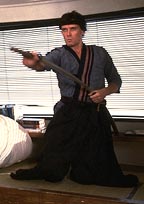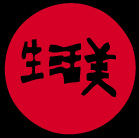
AT HOME WITH BUCKAROO BANZAI
 Blame it on our
celebrity-worshiping culture, but there seems to be an unquenchable
thirst for details concerning Buckaroo Banzai's daily life.
Blame it on our
celebrity-worshiping culture, but there seems to be an unquenchable
thirst for details concerning Buckaroo Banzai's daily life.
High Sierra and I recently had the privilege of touring Buckaroo's
private apartments, and, let me tell you, there's not much to
tell.
In fact, there's little difference between his modern digs
and those of ancient times. The "living" room
where he receives guests contains about eight mats and numerous
saddles which serve as chairs for his western guests, and that's
about it, while the adjoining room is a smaller apartment containing
perhaps three or four mats and a Turkey carpet. He also
has a third room, where only his most intimate guests are allowed
to enter.
 The "living" room is
large and bright and fitted with the usuasl toko-no-ma (alcove)
and chigai-dana (a recess with two shelves); in the former
hang pictures and specimens of caligraphy by noted Japanese artists.
In addition, cut flowers are arranged in vases of Kutani porcelain;
these flowers are changed according to the season. There
will also be found musical instruments such as the koto, bongo
drums, and a guitar, as well as numbers of sundry knicknacks,
such as a Wedgwood inkstand, a shelf-ornament in the shape of
a jack rabbit, made of crystal, which is perched on a tiny cushion
of daintily dyed crepe; a hanging clock, a handsome mirror, a
framed oil-painting of the Priddy sisters; a small library of
novels, magazines, theatrical notices, playbills, and other light
reading matter designed to beguile the tedium of his guests --
yet, curiously, also an edition of the Xenophon in sixteen volumes.
The "living" room is
large and bright and fitted with the usuasl toko-no-ma (alcove)
and chigai-dana (a recess with two shelves); in the former
hang pictures and specimens of caligraphy by noted Japanese artists.
In addition, cut flowers are arranged in vases of Kutani porcelain;
these flowers are changed according to the season. There
will also be found musical instruments such as the koto, bongo
drums, and a guitar, as well as numbers of sundry knicknacks,
such as a Wedgwood inkstand, a shelf-ornament in the shape of
a jack rabbit, made of crystal, which is perched on a tiny cushion
of daintily dyed crepe; a hanging clock, a handsome mirror, a
framed oil-painting of the Priddy sisters; a small library of
novels, magazines, theatrical notices, playbills, and other light
reading matter designed to beguile the tedium of his guests --
yet, curiously, also an edition of the Xenophon in sixteen volumes.
On the chigai-danarests a deep lacquered tray and other
objects, while the room invariably contains a clothes-horse and
a six-fold screen (roku-mai-ori-no-byodu).
In the private apartment is a shelf on which Buckaroo's pistols
and store of ammunition are placed, and this covered with a bright
green furoshikion which is dyed the ornamental figure
of his family badge (a pair of bamboo leaves turned downward
and topped by three simple flowers). Below this shelf is
a chest of drawers containing his wardrobe, while the other articles
of furniture consist of an oblong brazier on which is placed
a kettle, a cupboard with a glass door within which yo-cha-ki
(tea things) and eating and drinking utensils are neatly arranged,
a mirror-stand, a cup used for gargling, a mimi-darai
(a metallic or lacquer tub with a pair of handles or ears, used
for toilet purposes), cushions and various other paraphernalia,
such as a laptop computer and CD-player.
His futon is a regular style, three of which have been laid one upon the other to form a nice soft bed, his only concession to personal comfort.
--Appaloosa
|
|
|
|